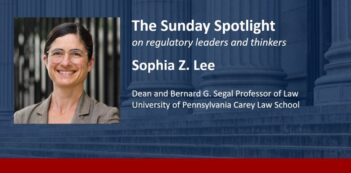
Two Supreme Court decisions raise questions about the role of states in emerging electricity markets.
For 60 years, the line between federal and state regulatory jurisdiction over the nation’s rapidly-changing electricity markets seemed relatively clear. The Federal Power Act grants the Federal Energy Regulatory Commission (FERC) jurisdiction over wholesale sales of electricity in interstate commerce, but leaves jurisdiction over retail sales and electricity generation to state public utility commissions.
Over the past two decades, however, the growth of competitive multi-state, wholesale power markets has challenged that understanding. These multi-state, wholesale power markets are managed by independent system operators (ISOs) or regional transmission organizations (RTOs), nonprofit organizations comprised of utilities and other transmission and generation organizations.
The growth of multi-state, wholesale power markets has also triggered conflict between ISOs/RTOs and FERC, on the one hand, and states, on the other. Two recent Supreme Court rulings affirming federal authority over wholesale markets raise as many questions as they answer about this boundary line.
In Federal Energy Regulatory Comm’n v. Electric Power Supply Ass’n (EPSA), the Court upheld FERC’s Order 745, a rule requiring ISOs/RTOs to allow providers of demand response resources (consumers willing to be compensated for reducing demand on relatively short notice) to compete with generators in wholesale power markets when it is economical to do so. It also requires ISOs/RTOs to compensate providers of demand response resources at the market price for electricity.
The U.S. Court of Appeals for the D.C. Circuit had originally vacated Order 745, holding that demand response resources are forgone retail sales that are properly subject to state, not federal, jurisdiction. The D.C. Circuit separately held that the compensation provisions of the rule are arbitrary and capricious under the Administrative Procedure Act (APA) because they overcompensate demand response resources providers.
The Supreme Court, in an opinion by Justice Kagan, reversed the D.C. Circuit on both issues, with Scalia and Thomas dissenting.
The Court’s treatment of the jurisdictional issue will be of particular interest to energy lawyers and policymakers. The Federal Power Act grants FERC jurisdiction over practices that directly affect wholesale rates. The Court noted that Order 745 is structured so that demand response resources put downward pressure on wholesale prices—therefore, the deployment of demand response resources in wholesale markets directly affects wholesale rates.
Whatever effects Order 745 may have at the retail level, it is aimed exclusively at wholesale markets, so it does not run afoul of the Federal Power Act’s proscription against federal regulation of retail sales. The Court then noted that the rule furthers the Federal Power Act’s core purposes to fill regulatory gaps and ensure that prices remain “just and reasonable.”
About six months after the Court handed down its decision upholding Order 745, the Court also decided Hughes v. Talen Energy Marketing, which affirmed federal power over competitive wholesale markets in another way. Hughes concerned a conflict between PJM Interconnection (PJM), a multi-state RTO, and two of the states within PJM’s borders—namely, Maryland and New Jersey.
PJM runs an annual “capacity auction” to procure future generating capacity, paying the winning bidders to be available to provide electricity at designated times in the future.
Troubled by higher power prices in eastern PJM and believing that PJM’s capacity auction was not encouraging sufficient new power plant construction in their respective states, New Jersey and Maryland each enacted policies requiring their electric distribution companies to enter into contracts with the owners of designated new power plants.
Under these contracts, distribution companies were to pay power plants’ owners the difference between the clearing price in the PJM capacity auction and a specified contract price. In this way, the plants owners would make money even if their power plants were not among the winning bids in the PJM capacity auction.
The U.S. Courts of Appeals for the Fourth Circuit and the Third Circuit, respectively, struck down the Maryland and New Jersey programs on federal preemption grounds under the U.S. Constitution’s supremacy clause. In an opinion by Justice Ginsburg, the Supreme Court affirmed both lower court decisions, concluding that these state laws invaded FERC’s regulatory jurisdiction by directly influencing the rate paid for capacity from these subsidized plants.
Capacity payments are wholesale transactions, said the Supreme Court, and the Federal Power Act reserves regulation of wholesale rates to FERC. Maryland and New Jersey had argued that these subsidy schemes were attempts to manage the portfolio of electricity generation plants within their borders, an activity traditionally within state jurisdiction.
But the Court rejected the state’s argument, saying that “states may not seek to achieve ends, however legitimate, through regulatory means that intrude on FERC’s authority over interstate wholesale rates.”
The Supreme Court’s decisions in its electricity cases this term—EPSA and Hughes—raise two sets of interesting issues.
First, both decisions underscore ways in which states have lost regulatory leverage in the transition from traditional regulation to competitive power markets. In parts of the country that retain traditional regulation (mainly the southeast), there are few arms-length wholesale power sales: the same company that sells power at retail also generates most of that power. State public utility commissions retain the right to require the utility to employ demand response resources, the right to approve particular additions to the generation mix, and the right to decide how the utility will be compensated for those power plant investments. By contrast, in ISO/RTO markets where retailers must acquire power from third parties at competitive prices, state public utility commissions no longer control the terms governing those upstream decisions. That power lies with FERC.
Second, the Hughes decision raises questions about how states can continue to subsidize preferred merchant (non-utility) generators. Most states have policies favoring renewable power: either renewable portfolio standards (RPS), which effectively create a market for renewable power, or “feed-in tariffs,” which guarantee renewable generators a minimum price for their power. Some states—like Ohio, Illinois, and New York—have been considering direct payments to nuclear or fossil-fueled generators to ensure the future reliability of the system. Can these sorts of state programs survive Hughes?
The Court tried to narrow its holding, noting that it was not addressing the legality of state measures to “encourage development of new or clean generation.” But its rationale seems to call into question some of the things states do to promote generation. One might distinguish an RPS from the Maryland and New Jersey schemes in that the latter involved direct attempts to alter wholesale prices; conversely; RPSs only alter wholesale prices indirectly by creating a demand for renewable power that might not otherwise exist.
However, feed-in tariffs and the reliability payments contemplated by Ohio, Illinois, and New York represent direct payments to generators that alter their effective wholesale rates, just as the Maryland and New Jersey schemes did.
As competitive electricity markets grow and evolve, and as states begin to grapple with the integration of rooftop solar power and other “distributed energy resources” onto the grid, these same kinds of questions about where federal regulatory jurisdiction over competitive electricity markets ends and state jurisdiction begins will continue to be raised and will need to be answered.
This essay is part of The Regulatory Review’s seven-part series, The Supreme Court’s 2015 Regulatory Term.




